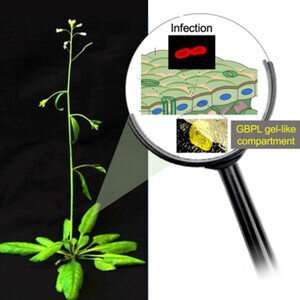How plants ward off a dangerous world of pathogens

The world's plants, immobile and rooted in soil which contains potentially lethal micro-organisms, face a constant threat from invading pathogens. In recent years, however, scientists have discovered that plant species employ sophisticated immune strategies that differ from —but also shares similarities with—the ways humans combat infections.
In a study published May 26 in the journal Nature, Yale scientists describe a key molecular "on-off" switch that enables plants to mobilize immunity in the face of microbial pathogens. The findings not only have direct implications for crop management and possibly protecting plants from the effects of climate change, but also for better understanding the human immune system as well.
"Plants are more related to us, in certain respects, than we commonly think," said senior author John MacMicking, a Howard Hughes Medical Institute Investigator, a member of Yale's Systems Biology Institute at West Campus, and an associate professor of microbial pathogenesis and immunobiology at Yale School of Medicine. "For example, they have many innate immune gene families that are similar to ours, and historically plants have been used to establish fundamental principles of host defenses and disease tolerance."
Unlike humans, plants lack an adaptive immune system that "remembers" specific pathogens and then organizes a tailored defense. In the study, MacMicking and his colleagues explored the sophisticated cell-autonomous defense programs that plants do employ against pathogens. It turns out that what they lack in tailored antibodies, they make up for by greatly expanding their repertoire of innate immune responses, which mount a more generalized defense against all infections.
For instance, one of these strategies involves innate immune proteins that morph into a "gel-like" state in order to trigger immune responses. This process—called liquid-liquid phase separation—enables biological activities to be concentrated in membrane-less compartments inside cells. The Yale team discovered that plant immune proteins, known as guanylate-binding protein-like (GBPL) GTPases, create liquid-like compartments within the nucleus that creates a concentration of proteins that drive the activity of host defense genes during infection. This phase-separated compartment also excludes inhibitory proteins to the outside of the nucleus as part of a spatially separated "on-off" switch.
Liquid-liquid phase separation is a new frontier in understanding how cells compartmentalize their biological activities, MacMicking said.
"All organisms, from single-celled bacteria to plants to humans, defend their genome from outside threats," MacMicking said. "Phase-separation may be a pervasive evolutionary mechanism to organize these defense activities as part of the cell-autonomous immune response."
More information: Shuai Huang et al, A phase-separated nuclear GBPL circuit controls immunity in plants, Nature (2021). DOI: 10.1038/s41586-021-03572-6
Journal information: Nature
Provided by Yale University





















